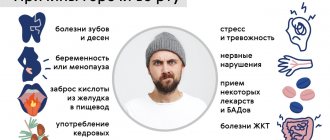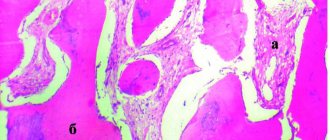Vomiting is a forced, uncontrolled expulsion of stomach contents
or intestines through the mouth with the participation of the abdominal muscles and diaphragm. Vomiting is also accompanied by weakness, drooling, watery eyes and dizziness. Both the feeling of nausea and vomiting are triggered by a special nerve center located in the brain stem. The signals come from sensitive receptors in the digestive tract, so irritation of these receptors triggers the gag reflex. Irritation of the sensitive receptors of the gag reflex occurs, for example, with strong stretching of the walls of the stomach, with eating foods with an irritating effect, with inflammation of the walls of the stomach and intestines (gastritis, gastroenteritis). Direct irritation of the “vomiting center” can also cause vomiting, even if there is no irritation from the digestive tract. This phenomenon is observed in various diseases of the nervous system.
Causes of nausea and vomiting
Vomiting does not always indicate a disease of the digestive tract, but most often the cause of vomiting and nausea is found in the digestive system.
- Gastroenteritis, or inflammation of the stomach and intestines, due to ingestion of poor-quality food, contaminated water, leading to the development of food poisoning.
- Long-term (chronic) diseases of the stomach (chronic gastritis, gastric ulcer, gastroparesis - complete lack of mobility and contractions of the stomach), stomach spasm (persistent tension of the stomach muscles, with the impossibility of passing food further), duodenal ulcer, duodenitis.
- Diseases of the gallbladder and liver, cholelithiasis, dyskinesia of the gallbladder, cholecystitis, blockage of the bile ducts, hepatitis.
- Emergency conditions: acute appendicitis, pancreatitis, cholecystitis, intestinal obstruction, perforation of a gastric or duodenal ulcer, gastric bleeding, etc.
- Anomalies in the development of the digestive system: diverticulum (blind appendage) of the esophagus, intestines usually lead to periodic nausea and vomiting.
- Stenosis (narrowing of the lumen) of the esophagus or pylorus.
- Tumors of the stomach and intestines.
Sudden nausea and vomiting, accompanied by rumbling in the stomach, diarrhea, mild fever, and weakness are most often a sign of food poisoning
. If food poisoning is suspected, the stomach should be rinsed with plenty of liquid. You can also drink activated carbon.
Nausea and vomiting accompanied by severe diarrhea (possibly mixed with blood), a significant increase in temperature, and severe weakness may be a sign of an intestinal infection. Severe nausea and vomiting, accompanied by discoloration of stool, dark urine and jaundice, are a clear sign of viral hepatitis. If you suspect hepatitis or acute intestinal infection, you should urgently show the patient to a doctor.
Nausea and vomiting that occur periodically (often) accompanied by symptoms such as abdominal pain, stomach pain, sour belching, bitterness in the mouth, stool discoloration, chronic diarrhea, constipation, are usually a symptom of gastritis, peptic ulcer of the stomach and duodenum, cholecystitis, chronic hepatitis, chronic pancreatitis. In these cases, treatment of nausea and vomiting
possible only after eliminating the underlying disease.
Since the initiation and process of vomiting itself is controlled by the “vomiting center” of the brain, some diseases of the nervous system can cause vomiting and nausea. Increased intracranial pressure is characterized by a persistent increase in cerebrospinal fluid pressure and compression of the brain. A slow increase in intracranial pressure is observed, for example, with brain tumors. In such cases, nausea and vomiting occur either in the morning, or mild nausea is observed throughout the day. Along with nausea, the patient may complain of headache, balance disorder, blurred vision, disturbances in gait or sensitivity, or weakness in any part of the body.
A sharp increase in intracranial pressure (cerebral edema, traumatic brain injury, concussion, bruise) is accompanied by severe vomiting and impaired consciousness.
Attention!
Persistent headaches accompanied by nausea or periodic “unreasonable” vomiting may be a sign of brain tumors or other diseases characterized by a slow increase in intracranial pressure! If you notice this symptom, you should immediately consult a doctor.
Infectious diseases of the nervous system (meningitis, borelliosis), damage to the nervous system due to syphilis or AIDS are also accompanied by vomiting. Of the conditions described, meningitis is most often observed. Nausea and vomiting may be among the first symptoms of meningitis. Attention!
In addition to nausea and vomiting, meningitis causes high fever, severe headache, and severe tension in the neck muscles. If these signs are detected, you should immediately call a doctor! Lesions of the vestibular apparatus (vertigo, motion sickness, motion sickness) are often accompanied by nausea and vomiting in combination with severe dizziness and loss of balance. With benign vertigo, nausea and dizziness occur suddenly at the moment when the patient abruptly changes the position of the body and head (for example, turning on the other side in bed). With seasickness or motion sickness, nausea and vomiting occur during travel by sea or land. If such symptoms are detected, you should contact a neurologist or otoneurologist!
Migraine is a special type of headache that occurs in 15-20% of the population. With migraine, nausea and vomiting occur against the background of a severe (sometimes throbbing) headache. In addition to nausea and vomiting, during a migraine attack there is photophobia (the patient cannot tolerate bright light) and noise intolerance. Migraine attacks recur periodically and can be triggered by foods such as wine, chocolate, cheese, and strong odors. If you suspect a migraine, you should consult a neurologist!
Treatment methods
Basically, the treatment of bitterness in the mouth comes down to taking medications. The specialist selects complex therapy based on the results of tests and instrumental examinations. The gastroenterologist identifies one of three problems:
- Liver disorders. Means are prescribed to stabilize the operation of the “filter”,
- Digestive tract dysfunction. Drugs that affect the digestive system normalize the work
- Uncontrolled bile production. Eliminated by drugs that affect the level of secretion, for example, anticholinergics.
Other causes of vomiting
- Myocardial infarction, arterial hypertension. With high blood pressure, vomiting is combined with a severe headache. During a heart attack, vomiting occurs simultaneously with severe chest pain.
- Diabetes mellitus in case of non-compliance with treatment regimens and diet. In this case, vomiting is combined with severe thirst and frequent urination. Severe vomiting in diabetes may be a sign of impending ketoacidosis.
- Kidney disease in the final stages (renal failure).
- Some medications may have the side effect of vomiting. If vomiting occurs during treatment with any drug, you should consult the doctor who prescribed the drug.
- Mental factors: stress, fear, anorexia, excitement, severe pain, individual unpleasant associations with any food, smell, taste, situation can also provoke nausea and vomiting. Recurrent vomiting may be a symptom of hysteria.
Bend of the gallbladder
A substance called bile is concentrated in the gallbladder and is actively involved in digestion, and in particular in the breakdown of fats. Bile enters the duodenum through the common bile duct, where it performs its functions.
Often the cause of vomiting with a small amount of bile is a bend in the gallbladder. This pathology has become increasingly common in children aged 6-10 years in recent years. It is often asymptomatic, but if the bend completely blocks the bile ducts, the disease can be accompanied by acute pain, loss of appetite, nausea and vomiting. If a set of such symptoms appears, you should immediately go to the hospital. The doctor will prescribe treatment and determine a diet. If a child has been diagnosed with a bent gallbladder, there is no need to panic.
As a rule, the child outgrows this pathology. The internal organs also grow and the gallbladder usually levels out. Diet is important to ensure that the gallbladder does not work with overload, does not produce more bile than it can dump into the intestines, and that stones do not form.
Nausea and vomiting during pregnancy
Nausea and vomiting are possible signs of pregnancy. In pregnant women, nausea usually occurs in the morning and is accompanied by slight dizziness, weakness, and drowsiness. Nausea and vomiting in pregnant women are symptoms of early gestosis (toxicosis). The occurrence of nausea and vomiting in a pregnant woman may be a sign of worsened pancreatitis, gastritis, gastric ulcer, treatment with iron supplements, therefore, in all cases of nausea and vomiting in pregnant women, this problem should be discussed with doctor.
Why is vomit green?
The standard signs poisoning are familiar to all medical workers, and the first of them is the green color of vomit. It occurs for two reasons:
- there is excess bilirubin in the blood;
- there was a release of liquid secretion into the stomach.
Both the first and second reasons are what uncontrolled drinking leads to. That is, poisoning occurs. If you feel sick with bile after drinking alcohol, your loved one can be helped at home or taken to a medical facility. People with chronic or serious gastrointestinal tract diagnoses at great risk After ethanol poisoning, they may experience complications that will have a bad effect on their future health.
Vomiting in children
Vomiting
occurs more often in children than in adults because the structures in their stomach and brain that prevent food from being expelled through the mouth are not fully developed. In a child, any infections, including ENT organs, fever, rotavirus infection, food poisoning can cause nausea and vomiting. In addition, children are more emotionally sensitive, so often a child’s vomiting can be associated with a dislike for a particular food that has unpleasant memories associated with it. In newborn babies, vomiting should not be confused with regurgitation. A healthy child normally regurgitates 5-10 ml of stomach contents several times a day; regurgitation is associated with food intake and can be a sign of overeating, and can also occur as a result of rapid feeding and swallowing air. However, if the child regurgitates too often and is accompanied by the expulsion of a large amount of stomach contents (vomiting), the baby is not gaining weight well - you should show the child to the doctor, as this may be a symptom of stenosis of the esophagus or pylorus. In older children, vomiting may occur as a result of acute appendicitis or gastroenteritis, in which case the child experiences vomiting and diarrhea with fever and severe abdominal pain. Vomiting, fussiness, a crying baby, no bowel movements, or jelly-like, raspberry-colored stools may indicate intussusception (intestinal obstruction), which is an emergency. Worms can be a common cause of periodic nausea and vomiting in children. In all cases of episodic nausea and vomiting, a child should have a stool test for parasite eggs and, if necessary, undergo treatment. Migraine in children can cause recurrent bouts of vomiting. It is important to note that, unlike adults, migraine in children does not always manifest itself as a headache and for a long time can only manifest itself as episodes of vomiting or dizziness. Nausea and vomiting can occur in girls during the period of menstruation.
Attention!
Call a doctor if:
- Nausea or vomiting occurs several times and you do not know what is causing these symptoms.
- If you suspect that the cause of nausea may be food poisoning, try to give your child a gastric lavage before the doctor arrives.
- If nausea and vomiting occur in a child after a fall or injury (especially head and abdominal injuries).
- Nausea and vomiting in a child is accompanied by one or more of the following symptoms: headache, drowsiness, agitation, diarrhea, loss of consciousness, progressive deterioration of the child’s condition.
- Nausea and vomiting periodically recur in a child for no apparent reason.
What does the nature of vomiting indicate?
In all cases of vomiting, it is necessary to pay attention to the nature of the vomit:
- Vomiting blood
may indicate bleeding from a stomach or duodenal ulcer and is an indication for emergency treatment. Sometimes a person may not know that he has a peptic ulcer and the first symptom will be bleeding. In addition, vomiting blood occurs when bleeding from dilated veins of the esophagus in people with cirrhosis of the liver. - Vomiting blood mixed with foam most often indicates pulmonary hemorrhage.
- Vomit that is yellow or green in color and has a bitter taste indicates that it is bile. Vomiting bile indicates liver disease, gall bladder and often occurs after eating fatty foods.
Attention! In all cases of vomiting with blood (fresh or dark), the patient should be immediately shown to a doctor!
A man or woman vomits bile after drinking alcohol: what to do
Gastric lavage is the primary measure in case of poisoning. To cleanse the body, it is enough to drink 2 liters of clean water. But (!) this is provided that the person has not previously suffered a myocardial infarction and does not suffer from chronic diseases of the gastrointestinal tract or high blood pressure. Do not add any sweeteners or other ingredients to the water. The procedure is best performed in a sitting or standing position. In a difficult situation, cleansing is carried out on the side.
After gastric lavage, it is necessary to cleanse the intestines. An enema with warm water is used for this purpose. Using this procedure, it is possible to relieve pain and minimize the presence of toxins in the body. If bloating was observed, it will stop after the enema.
Note! The water temperature should be +35C.
Once the toxins are released, it's time to rehydrate. To do this, it is enough to drink small sips. clean (you can use mineral water, but still) water every 25 minutes.
If health does not improve, the patient should be placed on his side and allowed to fall asleep. In such a situation, you should not make sudden movements or lift weights. This will have a bad effect on your well-being.
As soon as the person wakes up and his condition improves, he can be offered chicken broth or oatmeal. After a couple of hours he can eat light soups.










